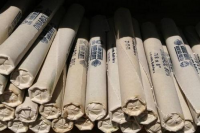








Dynamite is an explosive material based on nitroglycerin, using diatomaceous earth, or another absorbent substance such as powdered shells, clay, sawdust, or wood pulp. Dynamites using organic materials such as sawdust are less stable and such use has been generally discontinued. Dynamite was invented by the Swedish chemist and engineer Alfred Nobel in Geesthacht, Germany, and patented in 1867. Its name was coined by Nobel from the Ancient Greek word ??????? dýnamis, meaning "power".
Dynamite is a high explosive, which means its power comes from detonation rather than deflagration. Dynamite is mainly used in the mining, quarrying, construction, and demolition industries, and it has had some historical usage in warfare. However the unstable nature of nitroglycerin, especially if subjected to freezing, has rendered it obsolete for military uses. Popular familiarity with dynamite led to metaphoric uses, such as saying that a particular issue is "political dynamite".
Dynamite consists of three parts nitroglycerin, one part diatomaceous earth and a small admixture of sodium carbonate. This mixture is formed into short sticks and wrapped in paper. A blasting cap and fuse of any length are then inserted down the middle. Nitroglycerin by itself is a very strong explosive, and in its pure form it is extremely shock-sensitive (that is, physical shock can cause it to explode), and degrades over time to even more unstable forms. This makes it highly dangerous to transport or use in its pure form.
Absorbed into diatomaceous earth or sawdust, nitroglycerin is less shock-sensitive. Over time, the dynamite will "weep" or "sweat" its nitroglycerin, which can then pool in the bottom of the box or storage area. (For that reason, explosive manuals recommend the repeated turning over of boxes of dynamite in storage.) Modern packaging helps eliminate this by placing the dynamite into sealed plastic bags, and using wax coated cardboard. Crystals will form on the outside of the sticks causing them to be even more shock, friction or temperature sensitive. This creates a very dangerous situation. While the risk of an explosion without the use of a blasting cap is minimal for fresh dynamite, old dynamite is dangerous.
Dynamite is usually sold in the form of cylinders about 8 in (20 cm) long and about 1.25 in (3.2 cm) in diameter, with a weight of about 0.5 lb troy (0.186 kg).Other sizes also exist. The maximum shelf life of nitroglycerin-based dynamite is recommended as one year from the date of manufacture under good storage conditions.
Another form of dynamite consists of nitroglycerin dissolved in nitrocellulose and a small amount of ketone. This form of dynamite is similar to cordite and gelignite, and is much safer than the simple mix of nitroglycerin and diatomaceous earth. Military dynamite achieves greater stability by avoiding the use of nitroglycerin and uses much more stable chemicals.
History and manufacture
Dynamite was invented by Alfred Nobel and was the first safely manageable explosive stronger than black powder. An industrialist, engineer, and inventor, the Swedish Nobel built bridges and buildings in Stockholm. His construction work inspired him to research new methods of blasting rock. Nobel obtained patents for his invention: in England on 7 May 1867 and in Sweden on 19 October 1867.He originally sold dynamite as "Nobel's Blasting Powder". Nobel decided to change the name to dynamite, after the Greek word for power, dýnamis. After its introduction, dynamite rapidly gained wide-scale use as a safe alternative to gunpowder and nitroglycerin. Nobel tightly controlled the patents, and unlicensed duplicating companies were quickly shut down. However, a few American businessmen got around the patent by using a slightly different formula.
South Africa
For several decades beginning in the 1940s, the largest producer of dynamite in the world was the Union of South Africa. There the De Beers company established a factory in 1902 at Somerset West. The explosives factory was later operated by AECI (African Explosives and Chemical Industries). The demand for the product came mainly from the country's vast gold mines, centered on the Witwatersrand. The factory at Somerset West was in operation in 1903 and by 1907 it was already producing 340,000 cases, 50 pounds (22 kilograms) each, annually. A rival factory at Modderfontein was producing another 200,000 cases per year.
Dynamite was dangerous to manufacture. There were two large explosions at the Somerset West plant during the 1960s. Some workers died, but the loss of life was limited by the modular design of the factory and its earth works, and the planting of trees that directed the blasts upward. There were several other explosions at the Modderfontein factory. After 1985, pressure from trade unions forced AECI to phase out the production of dynamite. The factory then went on to produce ammonium nitrate emulsion-based explosives that are safer to manufacture and handle.
United States
Dynamite was manufactured by the E. I du Pont de Nemours Company until the mid-1970s. Other American dynamite makers of that time period included the Hercules Corporation, Atlas, Trojan US Powder, Austin, and several other smaller firms. Dynamite has been mostly phased out in favor of water gel explosives, which are cheaper to manufacture, and in many ways safer to handle.
Currently only Dyno Nobel manufactures Dynamite in the US. The only facility producing the product is located in Carthage, Missouri, production is purchased from Dyno Nobel by other manufactures to put their label on the dynamite and boxes. Dynamite is still the product of choice for trenching applications, and as a cost-effective alternative to cast boosters.
In the United States, in 1885, the chemist Russell S. Penniman invented "ammonium dynamite", a form of explosive that used ammonium nitrate as a substitute for the more costly nitroglycerin. These dynamites were marketed with the trade name "Extra". Ammonium nitrate contains 85% of the chemical energy of nitroglycerin.